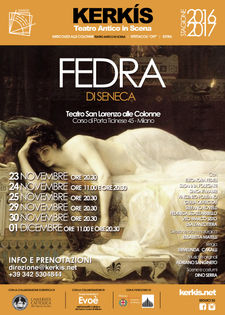
PHAEDRA
by Seneca
 |  |  |  |  |  |
|---|---|---|---|---|---|
 |  |  |  |  |  |
 |  |  |  |  |  |
 |  |  |  |  |  |
 |
«Io la riconosco, in me, la malattia mortale di mia madre, la sventurata: è nelle foreste che i nostri amori si trasformano in peccati. »
Phaedra, daughter of Pasiphaë, who gave birth to the bull-man, the Minotaur. Phaedra, daughter of Minos and sister of Ariadne, is now the wife of Theseus.
Alone and abandoned by her husband, who has been away from home for a long time, she now lives in the palace of Athens. Her amazement is reawakened at the sight of Hippolytus, her husband's son. Hippolytus is young and rebellious, and the profile of that teenager reminds her of Knossos. However, the boy, devoted to Diana, dedicates himself to a wild life: in the virgin and uncontaminated forest, which is Hippolytus's domain, Phaedra traces the one-way path of Fate.
The archetypal and ancient Greek myth of Phaedra is presented to a contemporary audience through the theatrical reinterpretation of the philosopher Seneca. In the drama, the author depicts a woman who is the victim of a passionate and forbidden love that irresistibly attracts her and, at the same time, repulses her. The strong, ambiguous and dual tones of this character, a wife neglected by her important husband and a mother who has fallen in love with her stepson, are enhanced by the theatricality that makes a strong impression on the audience.
With this kind of text, Seneca probably wanted to show the audience of his time (1st century AD), just as he does today, how destructive it can be to give free rein to impulses and passions that are not restrained by reflective wisdom.
Seneca's play Phaedra, presented for the first time in the form of a study in November 2016, is the result of in-depth research into the nature of Senecan drama. Reflection on the representability of the text, considered by many scholars to be a purely literary and non-theatrical work, has involved and continues to involve a large group of scholars, artists and researchers under the guidance of dramaturgical director Elisabetta Matelli. Association Kerkis.Teatro Antico In Scena has taken up the challenge: to what extent can the theatrical staging of this text demonstrate the true pedagogical meaning of the author's words?
Dramaturgical direction: Elisabetta Matelli
Stage direction: Eri Çakalli
Set design and costumes: Dino Serra and Chiara Barlassina



